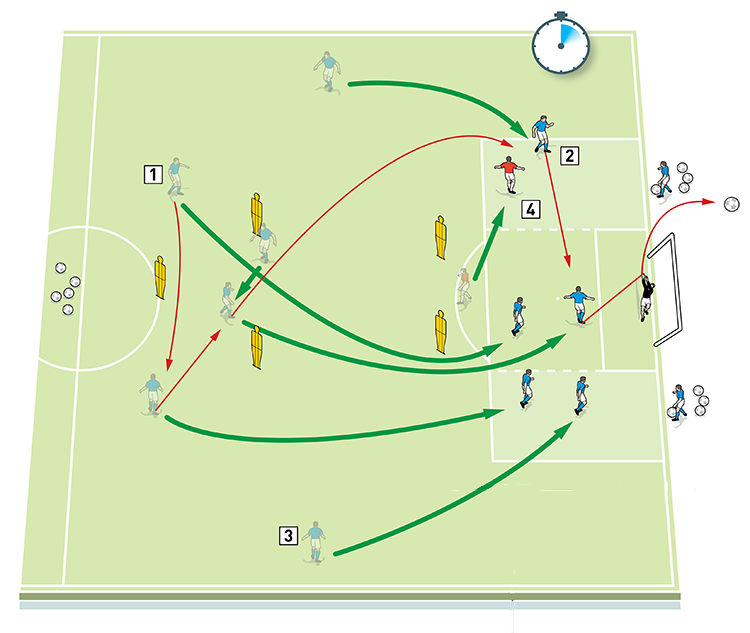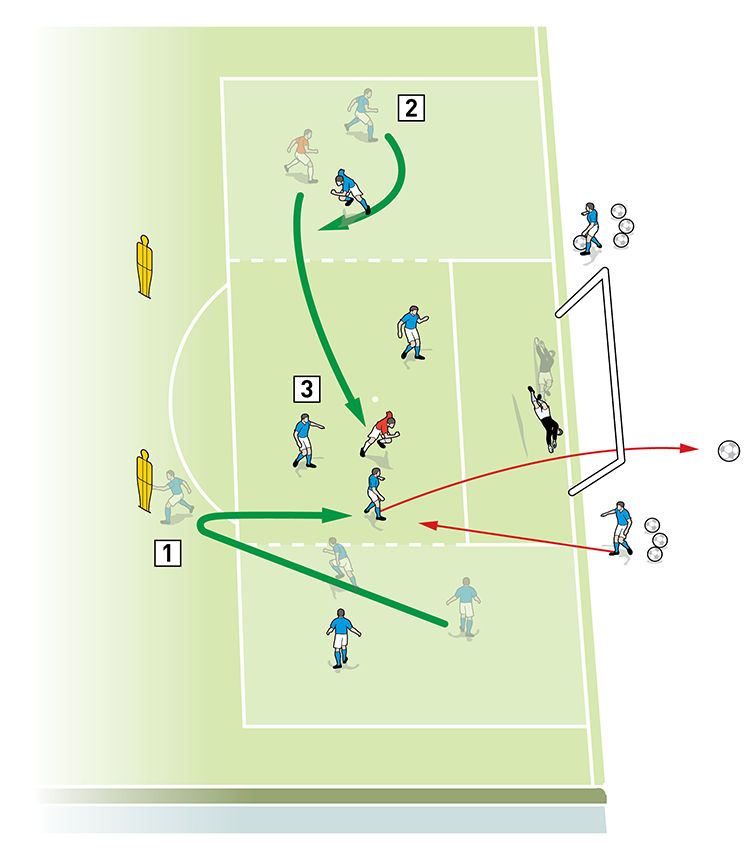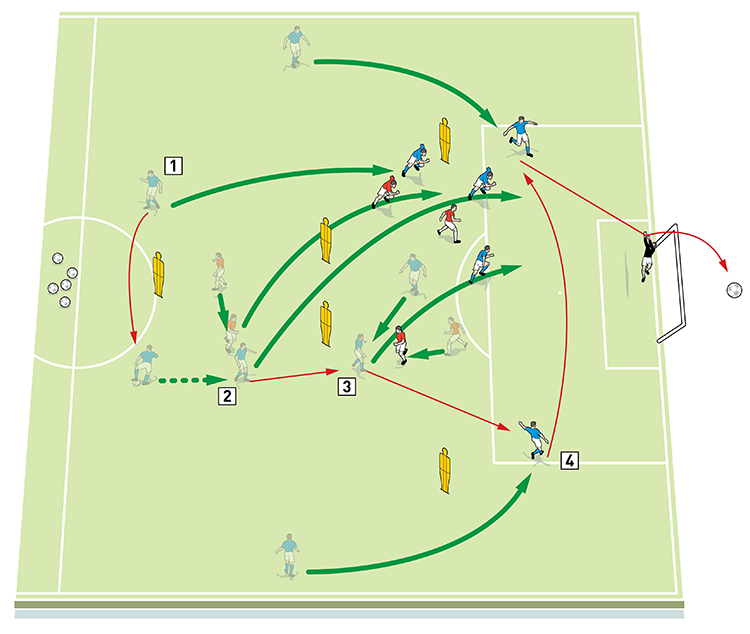




OUR BEST EVER OFFER - SAVE £100/$100
JOIN THE WORLD'S LEADING PROFESSIONAL DEVELOPMENT PROGRAMME
- 12 months membership of Elite Soccer
- Print copy of Elite Player & Coach Development
- Print copy of The Training Ground
Attacking crosses in a 4-3-3
| Area | Up to half a pitch |
| Equipment | Balls, bibs, cones, 5 mannequins, 2 full size goals |
| No. of Players | 8 players + 1 goalkeeper for the basic session but more for the game |
| Session Time | Attacking crosses 1: 10mins Attacking crosses 2: 15mins Attacking crosses game: 20mins |
This session focuses on attacking crosses when playing in a 4-3-3 formation and looks at what happens when the centre forward drops deep to link the game. It gives players plenty of opportunities to rehearse crosses from wide areas, as well as cut backs inside the penalty area, and it helps centre forwards to work on the timing of their link play and wide players to work on the timing of their runs in behind the full back to cross. It also helps develop a wide player’s ability to make supporting runs into the far side of the penalty area to finish on goal when the ball is crossed in from the opposite wing.
It is highly position-specific and the structure of the session allows for numerous progressions whilst keeping the same principles. Sometimes in a 4-3-3 the centre forward can become isolated and drops deeper to receive the ball; this session focuses on turning this into an area of strength, by overloading the midfield and allowing wide players the opportunity and freedom to roll inside the pitch and stretch the game in central areas.
The position-specific element means players can relate the session directly to the game. It also provides them with challenging repetition of the basic elements of their game such as crossing and finishing, which need to be performed at elite level.
The session is physically demanding, with added recovery runs after each phase of the attack. It is a good session for pre-season, as it can be tweaked to have a lot of position-specific running, whilst also focusing on team shape. If used in the season, we would focus more on the detail and timing of runs, and how to implement them against specific opponents rather than looking at the total physical output.
The structure of the session is fairly basic but it allows coaches to tweak the constraints and relate it more heavily to the opposition.
What do I get the players to do?
Attacking crosses 1
We set up on half a pitch, with a goal and a goalkeeper in their normal positions. We set up five mannequins, as shown. We’re using eight outfield players: seven are attackers and one is a defender. Five of the attackers start on the pitch and two are servers who start on either side of the goal.
To begin the drill, two midfielders combine to play the ball to the striker. The striker receives and plays a one-touch release pass into the wide area of the penalty box, where a wide player meets the ball on the run and crosses it first time. As soon as the release pass is made, both midfielders, the striker and the other wide player all make arcing runs on the outside of the centre back mannequin into the opposite side of the penalty area from the crosser, ready to meet the ball, as shown [1a]. The sole defending player must try to gain possession and clear the ball to the halfway line.
1a

2. The striker plays a one-touch release pass into the outside area of the penalty box to a wide player who is ready to cross first time
3. As soon as the release pass is made, both midfielders, the striker and the other wide player make arcing runs outside of the centre back mannequin into the opposite side of the penalty area from the crosser
4. The defender must try to gain possession and clear the ball to the halfway line
As soon as the first attack is dead, an attacker must break off and sprint to touch a centre back mannequin and turn to receive a second ball from one of the servers either side of the goal, as shown [1b], and try to score. When the second attack is dead, another player sprints to touch a mannequin and turns to receive another ball from a server for a third finish on goal.
1b

2. As soon as the ball is dead again, the blues repeat the second attack with another player running to touch a mannequin before receiving a ball
3. The defender must try to stop each attack and clear the ball to the halfway line
We play two blocks of four minutes.
Attacking crosses 2
We set up on half a pitch as before, with a goal and a goalkeeper in their normal positions. This time we set up the five mannequins as shown. We’re using eight outfield players: five are attackers and three are defenders. The attackers are made up of two midfielders, two wide players and a centre forward; the defenders are made up of a defensive midfielder and two centre backs.
Play begins as it did in the previous activity, with two midfielders combining to pass to the striker. As soon as the striker receives the ball, the next pass must be played forwards, linking play with a ball out to one of the wide players. As before, all remaining attackers must make runs into the far side of the penalty area to try and finish from the incoming cross, as shown [2].
2

2. The red defensive midfielder screens the pass into striker but doesn’t tackle
3. As soon as the striker receives the ball, the next pass must be forwards to one of the wide players
4. The wide player crosses into the penalty area. His team mates are making runs into the far side of the penalty area
The defenders can screen passes or put pressure on the attackers with an impact touch.
We play three blocks of four minutes.
How do I progress the session?
The progression shown in the second practice is just one of many possible follow-up activities. For instance, instead of adding two centre backs, it could be full backs to increase the thinking needed by the wide players.
Target goals could be added near the halfway line for the defenders and the recovering midfield player to pass into should they win the ball back rather than asking them to just clear the box.
How would I put this in a game situation?
Attacking crosses game
We set up between the penalty area and the halfway line, with a goal and a goalkeeper at each end. The main playing area is coned off to the width of the penalty box, with an unopposed crossing zone on each side. We’re using 14 outfield players for an 8v8 game including keepers but obviously it can be anything up to 11v11, depending on the numbers available.
A normal game is played within the main area with unlimited touches but the striker can release a runner into the unopposed wide zone for a one-touch cross, as shown [3]. A vertical offside line applies, meaning that players cannot stand in the wide zone to receive the ball and making the timing of any run into zone vitally important. As soon as the release pass is played into the wide zone, we want to see supporting players putting into practice what they learnt in the earlier activities by making runs into the far side of the penalty area to meet the cross.
3

2. The striker plays a release pass to a runner who darts into the unopposed wide zone
3. A vertical offside line applies, meaning that wide players cannot stand in the crossing zone to receive. They must time their runs perfectly and cross first touch
4. Supporting players make runs into the far side of the penalty area to meet the cross
We play two games of eight minutes each. We can progress the game by changing the restrictions; for instance, we could make the release pass one-touch but allow the crosser more than one-touch in the wide zone.
What are the key things to look for?
The tactical elements of the session can be built around whether we want to focus on our own team or the opposition. But it is important the players know the session is built around the core tactical philosophy of overloading the midfield to dominate the ball and ensuring that while we do that we always have runners offering a threat in behind.
Technically, this session focuses on many things, which are all highly position-specific. We want to see players understanding the importance of timing their runs. The timing and weight of the release pass is also vital and we want to see players using different types of finish, plus it is important that supporting players understand the team’s attacking shape when away from the ball.
What are the typical mistakes players might make and how do I avoid them?
Early in the session you often see players force the release pass and turn possession of the ball over; the game can be built and the players need to understand that element. It is not as simple as setting the ball to play through; extra passes and touches are often needed to settle the game before opposition teams can be opened up. In the session, the centre forward often plays on one-touch a lot as well. If the centre forward’s decision-making is good then they should also be thinking about getting turns away, releasing midfield runners and sliding wide player, not just bouncing it backwards.
Related Files
Editor's Picks
Attacking transitions
Deep runs in the final third
Using the goalkeeper in build-up play
Intensive boxes drill with goals
Penetrating the final third
Creating and finishing
My philosophy
Pressing initiation
Compact team movement
Coaches' Testimonials

Alan Pardew

Arsène Wenger

Brendan Rodgers

Carlos Carvalhal

José Mourinho

Jürgen Klopp

Pep Guardiola

Roy Hodgson

Sir Alex Ferguson

Steven Gerrard
Related
Coaches' Testimonials

Gerald Kearney, Downtown Las Vegas Soccer Club

Paul Butler, Florida, USA

Rick Shields, Springboro, USA

Tony Green, Pierrefonds Titans, Quebec, Canada
Join the world's leading coaches and managers and discover for yourself one of the best kept secrets in coaching. No other training tool on the planet is written or read by the calibre of names you’ll find in Elite Soccer.
In a recent survey 92% of subscribers said Elite Soccer makes them more confident, 89% said it makes them a more effective coach and 91% said it makes them more inspired.
Get Monthly Inspiration
All the latest techniques and approaches
Since 2010 Elite Soccer has given subscribers exclusive insight into the training ground practices of the world’s best coaches. Published in partnership with the League Managers Association we have unparalleled access to the leading lights in the English leagues, as well as a host of international managers.
Elite Soccer exclusively features sessions written by the coaches themselves. There are no observed sessions and no sessions “in the style of”, just first-hand advice delivered direct to you from the coach.







